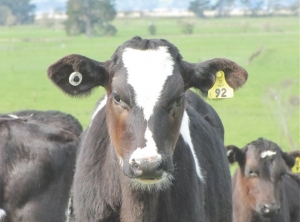The company’s veterinary advisor, Dr Clive Bingham, says Cooperia has had plenty of attention lately and can present more of a problem for some farmers than it did 10 years ago. This is partly due to the more intensive, single stock-class systems being run today, particularly by dairy grazers and bull beef farmers.
“Yes, it is more of a problem, but we can’t afford to take our eye off Ostertagia,.”
Cattle will typically develop a good level of immunity to Cooperia after only a few months of exposure. Immunity to Ostertagia does not develop as quickly, and even cattle up to two years of age can be significantly affected by it.
Ostertagia can have a greater impact on animal health at significantly lower numbers than Cooperia, and coming into spring can be a prime period when Ostertagia larvae – dormant over winter – reactivate as conditions become more favourable.
Recent work by AgResearch has established that oral drench treatments are the best way to treat Cooperia infestation1, Zoetis says. However Bingham believes more work needs to be done to determine the best method of administration for dealing with Ostertagia.
Bingham points to work done by Egerton which shows that higher doses of ivermectin are required to kill Ostertagia when given orally compared to by injection. A product’s ability to kill parasites is not only related to the drug concentration at the site of action but also to the period of time the parasite is exposed to an effective level of that drug.
Using long acting products such as Cydectin Injection and Cydectin Pour-On result in a high concentration of Moxidectin within the Abomasal mucosa for a long period of time. This is an important consideration when treating encysted L4 Larvae of Ostertagia.
When developing drenching programs for cattle, the differences in how a parasite feeds and its location in the digestive tract should be considered. For grazing heifers or bull calves weaned in summer, oral combination drenches could be administered through the autumn to cover the Cooperia risk. Ostertagia can then be controlled with the longer acting injectable or Pour-On endectocide products (e.g. Cydectin or Dectomax) going into and out of winter. A similar approach can also be taken for beef weaners. At this time of year, you are looking at beef weaner animals over 240kg live weight, and there are safety aspects that need to be considered when it comes to orally drenching animals of that size.
Using a drench that has persistent activity against production limiting parasites such as Ostertagia also means cattle don’t have to fight off ingested infective larvae. Instead, protein and energy that would have been used for this can be saved and used for improved productivity. The persistent acting products also allow more time between treatments without impacting on growth rates.
Bingham is also said to be encouraged by latest research from Lincoln University indicating the potential to reduce drench usage and maintain cattle growth rates.
“One of the biggest problems developing under intensive grazing systems is a build-up of resistance in worm populations and a lack of refugia.
Lincoln’s work has been to analyse weight gain in grazers. Those animals not meeting weight targets get drenched, while those that are, don’t get drenched.”
This system provides the opportunity to maintain populations of worms that are not exposed to drench as often and therefore less likely to become resistant to it.
“There is no single growth rate figure on such a system to stick to; every farm will be different in terms of weight targets, but it does show promise for maintaining drench effectiveness through refugia,” he says.
D.M. Leathwick, C.M. Millar. Efficacy of oral, injectable and pour-on formulations of moxidectin against gastrointestinal nematodes in cattle in New Zealand. Veterinary Parasitology (2013) 191, 293-300.
J.R. Egerton, C.H. Eary and D. Sukayda, The anthelmintic efficacy of Ivermectin in experimentally infected cattle. Veterinary Parasitology, 8 (1981) 59-70.
J. M. SALLOVITZ, A. LIFSCHITZ, F. IMPERIALE, G. VIRKEL & C. LANUSSE; A detailed assessment of the pattern of moxidectin tissue distribution after pour-on treatment in calves. J. vet. Pharmacol. Therap. 26, 397–404, 2003.









